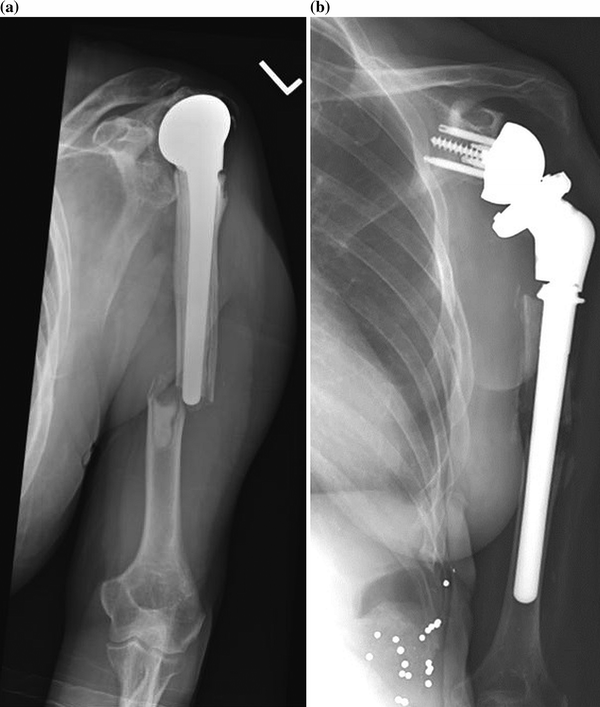Fig. 21.1
A 67-year-old female with poor result after proximal humerus fracture. a Preoperative radiograph reveals severe proximal humerus nonunion with bone loss. b Postoperative radiograph after shoulder reconstruction with RSA using a proximal humeral allograft-prosthesis composite technique. (Images contributed by Dr. M. Frankle)
An alternative technique of shoulder reconstruction has been proposed using reconstructive RSA designs without the use of allograft in the setting of proximal humeral bone loss (see Fig. 21.2). Exclusion of allograft bone augmentation avoids the additional cost of the graft, added operative time and complexity, and complications of infection, graft resorption, or nonunion. Budge et al. [14] recently published results of fifteen patients treated with this technique. Patients had average follow-up of 34.5 months and average preoperative bone loss of 38.4 mm (range, 26–72). Thirteen patients (87 %) reported satisfaction with their procedure. Only one patient experienced instability and later sustained a fracture of the humeral stem proximally at the modular metaphyseal connection two and a half years postoperatively. This reconstruction technique was preferred for several reasons. First, there is the avoidance of allograft cost and related complications of infection and nonunion. Second, the potential to reattach a chronically detached and deficient subscapularis to an allograft is most often unfeasible. Finally, the ability to establish rotational and length stability with only the use of long-stem components negates the need for structural allograft.


Fig. 21.2
A 56-year-old female with a history of shoulder hemiarthroplasty several years prior to her acute presentation with periprosthetic humerus fracture. a Preoperative radiograph showing periprosthetic fracture of the humeral shaft through the cement mantle. The shoulder demonstrates tuberosity bone loss and proximal migration of the prosthesis. b Postoperative radiograph after shoulder reconstruction using a long-stem RSA without the use of allograft
Several options exist for reconstruction, and choice of technique may depend largely on the amount of proximal bone deficiency. Boileau et al. [4] recently reported an analysis of thirty-seven patients after RSA revision, only ten of which had proximal humeral bone loss. Five patients were treated with a long monoblock RSA stem, three were treated with proximal humeral allograft stem supplementation, and two elderly patients were reconstructed with a built-up cement mantle around the stem. The authors stress their finding that humeral shortening and medialization increase the risk of instability, and failing to recognize this issue leads to insufficient deltoid tensioning and recurrent instability.
Intraoperative Technique
As discussed, restoration of soft tissue tension and stable fixation is the most important principles when performing RSA in patients with proximal humeral bone loss. A major element of this process is establishing appropriate implant positioning. Failure to position the humeral component of the reverse prosthesis at the proper height can result in instability. While preoperative templating can guide appropriate stem placement, the most accurate assessment of soft tissue tensioning and stability occurs intraoperatively. In cases of significant bone loss, this assessment is not as direct as when the bone is intact.
Depending on the indication for RSA and etiology of proximal humeral bone deficiency, several important steps must be taken regardless of chosen reconstruction technique. If an intact stem is to remain in the humerus, correct implant rotation should be verified. If a prior stem requires explantation or any cement requires removal, this should be performed before final assessment of bone loss, as more bone can be lost during this step. Even when no stem is in place, there remains a possibility of fracture during exposure of the deficient proximal humerus that can affect the need for augmentation. We recommend sampling the tissues for frozen section pathology to assess for acute inflammation (>5 PMNs/high power field) prior to implantation of a new implant.
Once infection has been ruled out and the final amount of bone loss can be appreciated, the assessment of implant positioning and stability can begin. The baseplate and planned glenosphere size and offset should be in place. The trial humeral stem is placed with approximate height correction. Trialing with various size polyethylene liners or spacers can also be done. Combinations of glenosphere size, humeral stem placement, and liner thickness can be trialed until finding an optimal amount of soft tissue tension and shoulder stability.
A sterile marker is then used to mark the level at which the trial humeral stem enters the proximal humerus. A similar marking is made on the final implant at this same location. With significant bone loss, the stem fixation will be distal and require either cementing into the diaphysis or the use of a long-stem revision system with roughened surface coating designed for uncemented use. The marking on the stem can be used to guide the appropriate height at which to cement the component. If allograft-prosthetic composite is planned, this marking can also guide the size of necessary allograft before it is cut. The allograft bone is prepared on the back table in preparation for implantation with the stem. A humeral neck osteotomy is performed, and the cancellous bone is cleared from the canal [10]. An appropriately sized allograft is then fashioned with a saw, often employing a step-cut configuration. The final stem implant is implanted into this graft, if used, prior to distal cementation into the patient’s native humerus.
It is recommended to trial the humeral liner once more prior to placing the final implant. A slight change in stem height during cementing may certainly change the polyethylene size needed. If accurate soft tissue tensioning is confirmed, the final liner should be implanted. In the unlikely event that any remaining subscapularis tendon is found intraoperatively, a repair should be attempted.
Stay updated, free articles. Join our Telegram channel

Full access? Get Clinical Tree








